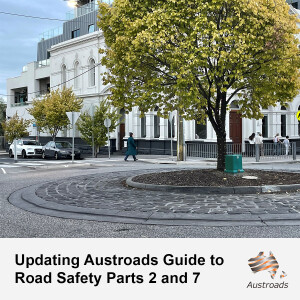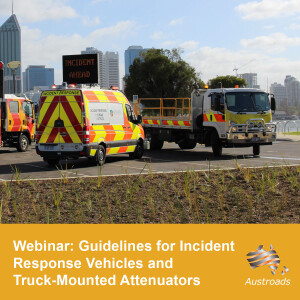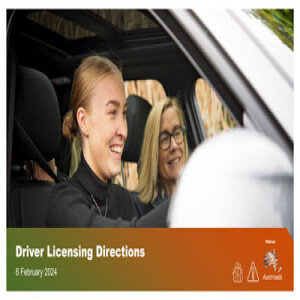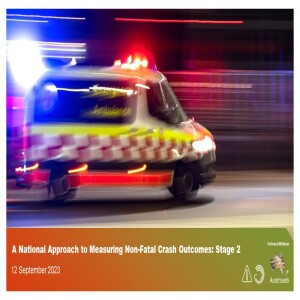Episodes

Thursday Jun 05, 2025
Thursday Jun 05, 2025
In this webinar, MACA Chief Executive Helen Lindner and Professor Julie Brown discuss an Austroads project for Australia and New Zealand investigating specialty harnesses and vests. These products are sometimes used by children and young people with disabilities and medical conditions when travelling in motor vehicles.
The project aimed to improve knowledge and understanding of why these products are used, how people are accessing them, their compatibility with different vehicle types, and their design and safety. In the webinar, the presenters outline the project aims, methodology, key findings, expert safety recommendations and next steps.

Thursday Jul 11, 2024
Gender Sensitive Urban Design Guidelines
Thursday Jul 11, 2024
Thursday Jul 11, 2024
Cities throughout the world are recognising many public spaces are not welcoming or inclusive, particularly for women, girls, gender diverse groups and vulnerable people.
This webinar, presented by Anna Chauvel and Richmond Henty, focuses on Canberra's first Gender Sensitive Urban Design Guidelines. The guidelines will help planners, engineers, architects, landscape designers and developers create urban spaces that reflect the needs, interests, and routines of the city’s diverse community, enriching people’s daily lives.
Developed following over two years of community and stakeholder engagement, the guidelines will aid with the design and delivery of public urban spaces as well as transport and infrastructure projects, including wayfinding. The guidelines are one of the actions to come out of the Second Action Plan 2020-22 of the ACT Women’s Plan.
The guidelines will deliver practical outcomes to the daily lives of women, girls, gender diverse and vulnerable people in Canberra improving their safety, access, mobility, health, and enjoyment in public spaces.

Tuesday Jul 09, 2024
How to Design Better Cities for Women and Girls
Tuesday Jul 09, 2024
Tuesday Jul 09, 2024
Safety is often the first thing that comes to mind when thinking about transport and city planning from a gender perspective, but feeling safe should be the baseline, not the benchmark when it comes to inclusive cities.
From Barcelona’s Superblocks to women’s cycling rates in Copenhagen, through to building women’s autonomy into the business case, this webinar’s presenter Estelle Grech shares key insights from her Churchill Fellowship where she travelled to 14 cities around the globe to research how to design cities for women in girls.

Wednesday Jul 03, 2024
Updating Austroads Guide to Road Safety Parts 2 and 7
Wednesday Jul 03, 2024
Wednesday Jul 03, 2024
The Austroads Guide to Road Safety Part 2: Safe Roads (AGRS Part 2) and Guide to Road Safety Part 7: Road Safety Strategy and Management (AGRS Part 7) have recently been updated.
AGRS Part 2 is designed to provide all levels of government across Australia and New Zealand with information on the role infrastructure plays in the Safe System. AGRS Part 2 presents guidance on the selection and implementation of infrastructure treatments to reduce road trauma and deliver a zero-harm future. These guidelines cover network risk assessment techniques and present a suite of infrastructure interventions (proven and emerging) that can be implemented to address the key road safety issues on our road networks: high-speed lane departures, intersections, and vulnerable road users. Interventions are categorised using a treatment hierarchy approach aligned with Safe System principles. The Guide contains practical, hands-on advice to help practitioners identify, prioritise, and deliver infrastructure interventions that are aligned with Safe System principles and the contemporary Zero Planning approach to road safety.
The AGRS Part 7 was expanded to include other network-wide concepts and processes, such as Network Safety Planning, Future State Modelling (backcasting) and Movement and Place Frameworks. It also identifies how the different parts/pillars of the Austroads Guide to Road Safety can be used to develop solutions that work towards network aspirations and significantly reduce serious road trauma.
This webinar, presented by Hafez Alavi and Paul Durdin, outlines the key changes to AGRS Part 2 and AGRS Part 7. The content includes examples from both guides that demonstrate how the updated guidance would be practically interpreted by practitioners to deliver treatment outcomes that are more aligned with the Safe System approach.

Tuesday Mar 05, 2024
Guidelines for Incident Response Vehicles and Truck-Mounted Attenuators
Tuesday Mar 05, 2024
Tuesday Mar 05, 2024
This webinar presents the results of the Austroads project that developed guidelines for incident response vehicles and truck-mounted attenuators. The project was a collaboration between Austroads, iMOVE, Queensland University of Technology and Deakin University.
Two sets of guidelines have been developed as part of the project. The first set provides information on models/types and design specifications of incident response vehicles. The guidance focuses on three vehicle types: tow trucks, truck-mounted attenuators (TMAs) and utility vehicles. In general, the design considerations are separated into three stages: determining models and general specifications, determining additional features and equipment, and determining markings, signs and other identification measures to ensure visibility and identifiability of the incident response vehicles.
The second set provides guidance on when and how TMAs and other attenuator vehicles should be used in incident response scenarios. The use of TMAs for incident response often requires departures from the established guidelines for TMA use, which are generally developed around planned operations (i.e. roadworks and maintenance activities). These issues are addressed alongside related considerations around broader temporary traffic management pertaining to incident response specifically.
In the webinar, presenters Narelle Haworth, Ashim Debnath and Drew Gaynor, provide an overview of the project, including the findings of the literature review, results of the stakeholder consultations and guideline development.

Thursday Feb 08, 2024
Is Zero Road Trauma Possible?
Thursday Feb 08, 2024
Thursday Feb 08, 2024
The United Nations Decade of Action for Road Safety 2021-2030 has set the ambitious global target to halve road traffic fatalities and injuries by 2030. Some jurisdictions have set even more ambitious targets by setting a date for achieving zero road trauma, such as by 2050.
While there is a growing body of evidence around what initiatives are effective in reducing road crashes and injuries, what is missing is how to prioritise these measures and a lack of tangible planning frameworks to assist countries to link near- and long-term targets with day-to-day operations.
This webinar explores how to use backcasting, a vision-based planning approach, to determine what the metrics of a safe road system should look like in order to achieve zero road trauma and how the current road system is tracking towards this desired state and how jurisdictions can utilise this approach to develop strategies to achieve their near- and long-term targets.
The webinar is presented by Jessica Truong, the winner of the Women in Road Safety Award presented by Austroads at the 2023 Australasian Road Safety Conference.

Tuesday Feb 06, 2024
Driver Licensing Directions
Tuesday Feb 06, 2024
Tuesday Feb 06, 2024
Driver licensing legislation and regulation is the responsibility of each of Australia’s 8 states and territories. However, there is a commitment by all jurisdictional regulators to harmonised practices with minimum licensing standards. Under the Austroads registration and licensing taskforce, states and territories agree periodic programs of work to improve licensing practice which recognises emerging research and trends and supports movement towards increasing road safety.
To guide the development of licensing practice in Australia all states and territories have agreed to the five principles of aspirational intent to guide and inform their licensing policy and work programs. This webinar outlines these five principles and describes some of the work currently underway in support of these principles.
The webinar is presented by Judy Oswin who has worked on driver licensing policy as both a state regulator and consultant for over 20 years.

Tuesday Jan 30, 2024
Changes to the National Heavy Vehicle Driver Competency Framework
Tuesday Jan 30, 2024
Tuesday Jan 30, 2024
Australia’s Transport Ministers have agreed in-principle to an improved, nationally‑consistent approach to the training and licence progression of heavy vehicle drivers, that improves road safety and productivity.
The in-principle changes were approved by infrastructure and transport ministers in December 2023 through the agreement by the Infrastructure and Transport Ministers Meeting (ITMM) to endorse the National Heavy Vehicle Driver Competency Framework Decision Regulation Impact Statement (Decision RIS).
The changes are designed to increase the safety and job‑readiness of heavy vehicle drivers.
Austroads will develop best-practice standards and training material to support consistent delivery of the enhanced heavy vehicle competencies and assessments.
Austroads will work with each state and territory government and the different industries to fully scope the implementation program, identify policy, service and stakeholder issues and options, and seek to collaboratively develop a coordinated plan to deliver the anticipated safety and productivity benefits of the reform.
In this webinar, Paul Davies, Austroads General Manager Programs, explains the changes in detail.

Wednesday Sep 13, 2023
Practical Approaches for Managing Regional Road Safety Priorities
Wednesday Sep 13, 2023
Wednesday Sep 13, 2023
Road users in regional and remote Australia are at a greater risk of road trauma than those living in major cities. Approximately one third of Australians live in regional or remote areas but two thirds of fatal crashes occur in these areas. The fatality rate in regional and remote areas is 12.2 deaths per 100,000 population and increases to 34.6 deaths per 100,000 in very remote areas. The former figure is almost five times greater than the rate for major cities which is 2.6 deaths per 100,000 population.
Austroads has completed a project to provide information on known effective road safety interventions for regional and remote areas.The information is presented in two reports. The first is the research report and the second report, which is based on the research report, is a shorter practitioner-focussed report which provides succinct and easy-to-access information via factsheets on evidence-based effective interventions, a prioritisation framework, and evaluation framework.
The evidence-based findings from this project provide practical guidance for practitioners to effectively select, prioritise, implement and evaluate interventions to prevent road fatalities and serious injuries in regional and remote areas.
This webinar provides a background to and overview of the project; highlights from the literature review; an overview of the factsheets and how they have been structured; a summary of the prioritisation framework and its application; and a summary of the evaluation framework and its application.
The webinar is presented by Dr Tana Tan, Dr Lisa Wundersitz and Dr Chris Stokes.

Tuesday Sep 12, 2023
A National Approach to Measuring Non-fatal Crash Outcomes – Stage 2
Tuesday Sep 12, 2023
Tuesday Sep 12, 2023
Information on injurious road crashes is required for prevention. National information on fatal cases has been available for many years, but information on serious non-fatal cases has been lacking. This webinar will take participants through the outcomes of Stage 2 of an Austroads project commissioned to establish a system to report serious injury cases due to road crashes in a consistent way throughout Australia and over time.
Stage 2 aimed to obtain ten years of data from all jurisdictions (2008 to 2017), report against equivalents to the NRSS fatality indicators and analyse characteristics of the data, including matched and unmatched cases, cross-border flows, and the impact of data linkage on estimates. Ethics and data custodian approvals enabled data to be collected from all jurisdictions except Western Australia.
Information on injurious road crashes is required for prevention. National information on fatal cases has been available for many years, but information on serious non-fatal cases has been lacking.
Webinar presenters Professor James Harrison and Associate Professor Angela Watson explain the method used in Stage 2 of the project and provide a detailed overview of the project findings.

